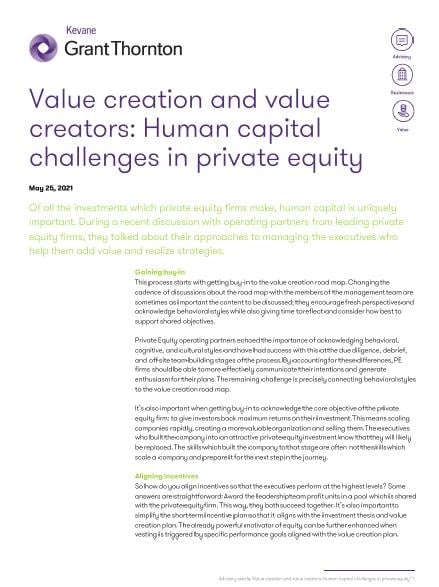-
Financial statements audits
Financial statement audits
-
Compliance audits
Compliance audits
-
Compilations and reviews
Compilations and audit
-
Agreed-upon procedures
Agreed-upon procedures
-
Corporate and business tax
Our trusted teams can prepare corporate tax files and ruling requests, support you with deferrals, accounting procedures and legitimate tax benefits.
-
International tax
Our teams have in-depth knowledge of the relationship between domestic and international tax laws.
-
Tax compliance
Business Tax
-
Individual taxes
Individual taxes
-
Estate and succession planning
Estate and succession planning
-
Global mobility services
Through our global organisation of member firms, we support both companies and individuals, providing insightful solutions to minimise the tax burden for both parties.
-
Sales and use tax and indirect taxes
SUT/ VAT & indirect taxes
-
Tax incentives program
Tax incentives program
-
Transfer Pricing Study
The laws surrounding transfer pricing are becoming ever more complex, as tax affairs of multinational companies are facing scrutiny from media, regulators and the public

-
Business consulting
Our business consulting services can help you improve your operational performance and productivity, adding value throughout your growth life cycle.
-
Forensic and investigative services
At Grant Thornton, we have a wealth of knowledge in forensic services and can support you with issues such as dispute resolution, fraud and insurance claims.
-
Fraud and investigations
The commercial landscape is changing fast. An ever more regulated environment means organizations today must adopt stringent governance and compliance processes. As business has become global, organizations need to adapt to deal with multi-jurisdictional investigations, litigation, and dispute resolution, address the threat of cyber-attack and at the same time protect the organization’s value.
-
Dispute resolutions
Our independent experts are experienced in advising on civil and criminal matters involving contract breaches, partnership disputes, auditor negligence, shareholder disputes and company valuations, disputes for corporates, the public sector and individuals. We act in all forms of dispute resolution, including litigation, arbitration, and mediation.
-
Business risk services
We can help you identify, understand and manage potential risks to safeguard your business and comply with regulatory requirements.
-
Internal audit
We work with our clients to assess their corporate level risk, identify areas of greatest risk and develop appropriate work plans and audit programs to mitigate these risks.
-
Service organization reports
As a service organization, you know how important it is to produce a report for your customers and their auditors that instills confidence and enhances their trust in your services. Grant Thornton Advisory professionals can help you determine which report(s) will satisfy your customers’ needs and provide relevant information to your customers and customers’ auditors that will be a business benefit to you.
-
Transactional advisory services
Transactions are significant events in the life of a business – a successful deal that can have a lasting impact on the future shape of the organizations involved. Because the stakes are high for both buyers and sellers, experience, determination and pragmatism are required to bring deals safely through to conclusion.
-
Mergers and acquisitions
Globalization and company growth ambitions are driving an increase in M&A activity worldwide as businesses look to establish a footprint in countries beyond their own. Even within their own regions, many businesses feel the pressure to acquire in order to establish a strategic presence in new markets, such as those being created by rapid technological innovation.
-
Valuations
We can support you throughout the transaction process – helping achieve the best possible outcome at the point of the transaction and in the longer term.
-
Recovery and reorganization
We provide a wide range of services to recovery and reorganisation professionals, companies and their stakeholders.
Gaining buy-in
This process starts with getting buy-in to the value creation road map. Changing the cadence of discussions about the road map with the members of the management team are sometimes as important the content to be discussed; they encourage fresh perspectives and acknowledge behavioral styles while also giving time to reflect and consider how best to support shared objectives.
Private Equity operating partners echoed the importance of acknowledging behavioral, cognitive, and cultural styles and have had success with this at the due diligence, debrief, and off-site team-building stages of the process. By accounting for these differences, PE firms should be able to more effectively communicate their intentions and generate enthusiasm for their plans. The remaining challenge is precisely connecting behavioral styles to the value creation road map.
It’s also important when getting buy-in to acknowledge the core objective of the private equity firm: to give investors back maximum returns on their investment. This means scaling companies rapidly, creating a more valuable organization and selling them. The executives who built the company into an attractive private equity investment know that they will likely be replaced. The skills which built the company to that stage are often not the skills which scale a company and prepare it for the next step in the journey.
Aligning incentives
So how do you align incentives so that the executives perform at the highest levels? Some answers are straightforward: Award the leadership team profit units in a pool which is shared with the private equity firm. This way, they both succeed together. It’s also important to simplify the short-term incentive plan so that it aligns with the investment thesis and value creation plan. The already powerful motivator of equity can be further enhanced when vesting is triggered by specific performance goals aligned with the value creation plan.
Key metrics typically go beyond EBITDA to a more balanced set of metrics which could include bookings, revenue, and growth. Because there is a natural offset between revenue growth percentage and EBITDA, a goal which combines the two often works well.
Of course, one key to managing the best executives is to not overmanage them. Participants believed in letting good teams do what they are best at. At the same time, the founding executives should have regular communication with the private equity firm and access to resources who can help them navigate the new water they’ve entered.
The board is key here. One emerging best practice is to have board members who can confidently and successfully lead in an executive capacity but who are not necessarily looking to fill a role in day-to-day leadership. This provides a ready successor without having current leadership feel like they have someone hoping that they fail. Instead, they can show by example what next level leadership looks like and also be prepared to step into a role very quickly, if a need does in fact arise.
Defining nonfinancial metrics
- discuss with firms and other PE firms about defining what a baseline might be to determine what “good” is
- initiating affinity groups across their holdings, to help define issues, formulate metrics, gather data, identify leaders, and suggest best practices to iterate the data so it is meaningful
- firms which do business internationally face additional challenges as inclusion contrasts in different parts of the world
Making transition decisions
Transition decisions are some of the hardest ones a private equity firm has to make.
The idea that one CEO is the right fit at all stages of development is increasingly outmoded. To facilitate that understanding, transparent conversations are important. Participants found that CEOs themselves do not want to be in a position they are no longer suited for and, if the decision is properly and respectfully communicated, they will often provide invaluable transition assistance. In some ways, the level of executives below the CEO may be more a difficult challenge, but the same principles of promptness and transparency still apply.
It’s important to develop candidates in advance and, if possible, familiarize them with the specifics of the acquired company.
Finally, traditional succession planning should not be overlooked. This gives both the board and management team confidence that the company will be in good hands—that the value creation plan introduced during the acquisition will, in fact, be realized. And that benefits all stakeholders.
Source: Grant Thornton library articles
